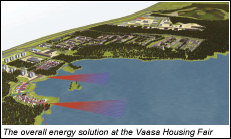Ecological Energy Production in Vaasa
In July-August Vaasa hosted the annual Finnish
Housing Fair. In addition to the beautiful, sturdy-built
homes and the latest trends in interior design, not only
national but also worldwide attention is directed to the
area thanks to implementation of pioneering energy production
processes.
 The
most noticeable ecological feature is the low-energy system,
which is unique in the world and utilises the warmth from
the seabed to heat up the houses. Electricity and heating
are produced and consumed within the area, making it almost
self-sufficient. The
most noticeable ecological feature is the low-energy system,
which is unique in the world and utilises the warmth from
the seabed to heat up the houses. Electricity and heating
are produced and consumed within the area, making it almost
self-sufficient.
Both energy production and distribution in
the Fair site are located in a power plant building known
as New Energy. The building consists of a fuel cell unit
and a micro-turbine unit, and is fuelled by biogas or methane
originating from a nearby landfill. The unique fuel cell
unit producing electric and heating power delivered by Wärtsilä
Oyj is based on planar solid oxide fuel cell (SOFC) technology
and is the first of its kind in the world. The landfill
gas used by the fuel cell power plant is a renewable fuel.
The significance of bi-ogases increases in decentralised
energy production. The benefits of decentralised energy
production include more efficient utilisation of local sources
of energy, shorter transport distances for fuels and reduced
energy transmission losses. In addition to landfills, biogases
are generated e.g. in agriculture and water treatment plants.
Moreover, Vaasan Ekolämpö Oy and
also Vaasan Sähkö Oy and KWH-Pipe Oy have created
a concept that has led to an energy self-sufficient housing
area at the Vaasa Housing Fair. Energy production from the
landfill gas and from the heat from the seabed sediment
is so high that it is possible to sell energy also outside
the housing fair area. There is also going to be another
housing area in Västervik where the heat from the rock
and drilled wells are used as an energy source. Wells are
also equipped with a coaxial pipe that gathers much more
heat than a traditional u-pipe. Drilled wells are connected
together and build the lowheat network. It is also planned
to equip houses with solar panels so that in the summer
it is possible to charge wells effective with solar heat.
|